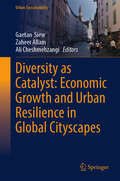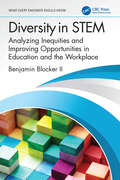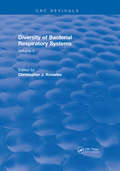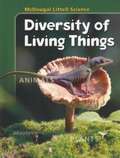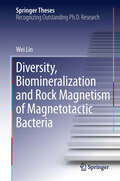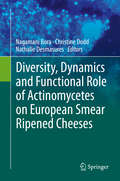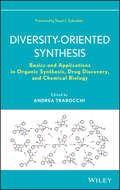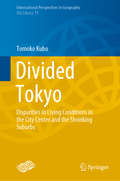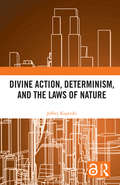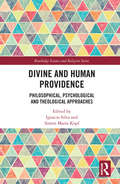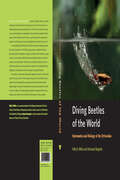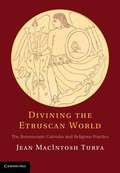- Table View
- List View
Diversity as Catalyst: Economic Growth and Urban Resilience in Global Cityscapes (Urban Sustainability)
by Ali Cheshmehzangi Zaheer Allam Gaetan SiewIn an era where global cities emerge as pivotal hubs for economic growth and cultural fusion, this book presents an innovative approach to understanding and leveraging the rich tapestry of diversity in urban environments. This book delves into how cultural diversity acts not just as a social asset but as a key driver of economic prosperity and urban resilience. What sets this book apart is its multidisciplinary perspective, combining insights from urban planning, economics, social sciences, and sustainability studies. It offers a fresh lens through which the dynamics of global cities are viewed, analyzed, and understood, aligning closely with Sustainable Development Goal 11 – making cities inclusive, safe, resilient, and sustainable. The scope of the book is both broad and deep, covering topics from the economic impact of cultural diversity in urban centers to strategies for balancing cultural heritage with modern urban development. It's a must-read for academics, policy makers, urban planners, and anyone interested in the future of urban living. Key features and benefits: Offers a unique blend of theory and practice, providing actionable insights for harnessing cultural diversity in urban development. Includes case studies and examples from cities around the world, making it relevant to a global audience. Directly aligns with global policy agendas, particularly SDG 11, offering a strategic guide for policymakers and urban developers.
Diversity in Coastal Marine Sciences
by Charles W. Finkl Christopher MakowskiThis book integrates a wide range of subjects into a coherent purview of the status of coastal marine science. Designed for the professional or specialist in coastal science, oceanography, and related disciplines, this work will appeal to workers in multidisciplinary fields that strive for practical solutions to environmental problems in coastal marine settings around the world. Examples are drawn from many different geographic areas, including the Black Sea region. Subject areas covered include aspects of coastal marine geology, physics, chemistry, biology, and history. These subject areas were selected because they form the basis for integrative investigation of salient environmental problems or perspective solutions or interpretation of historical context.
Diversity in STEM: Analyzing Inequities and Improving Opportunities in Education and the Workplace (What Every Engineer Should Know)
by Benjamin Blocker IIDiversity in STEM: Analyzing Inequities and Improving Opportunities in Education and the Workplace offers a survey of diversity in the broad field of Science, Technology, Engineering, and Mathematics (STEM) and provides potential solutions to improve outcomes in education, industry, and society. Offering a U.S.-based point of view, but with globally applicable concepts around race, gender, culture, politics, and socioeconomics, the book identifies where issues around diversity in STEM exist, how they were created, and how these issues are being addressed in STEM education and the STEM workforce.Features: Identifies conditions and causes of inequities from a societal perspective. Offers guidelines and solutions to identify and address cultural gaps in STEM. Covers STEM initiatives implemented at the K-12, college, and vocational levels and how they are beginning to alter the STEM landscape. Illustrates the benefits of fostering and maintaining a diverse, equitable, and inclusive workforce. Explores best practices used by companies and organizations to recruit, support, and develop diverse talent and strategies to continually evolve. Guides and empowers STEM professionals to seek out organizations whose values are aligned with their own. Providing an analytical and constructively practical viewpoint, the authors offer readers across the sciences, engineering, and medicine, as well as policymakers, the opportunity to consider why diversity and equity in STEM matter and how to apply best practices that support inclusivity to ensure successful outcomes for individuals, organizations, and society.
Diversity of Bacterial Respiratory Systems: Volume 1
by Christopher J. KowlesIt is the aim of this book to present reviews on a wide range of aspects of bacterial respiratory systems. Because the on-going publication elsewhere of reviews on bacterial respiration, ablanket coverage of the field has not been attempted. Rather, a range of topics have been selected, either because they are of special current interest, they have not been reviewed recently, or they have never been reviewed.
Diversity of Bacterial Respiratory Systems: Volume 2
by Christopher J. KowlesIt is the aim of this book to present reviews on a wide range of aspects of bacterial respiratory systems. Because the on-going publication elsewhere of reviews on bacterial respiration, ablanket coverage of the field has not been attempted. Rather, a range of topics have been selected, either because they are of special current interest, they have not been reviewed recently, or they have never been reviewed.
Diversity of Functional Traits and Interactions: Perspectives on Community Dynamics (Theoretical Biology)
by Akihiko MougiThis book presents new theoretical perspectives on ecological community dynamics and in so doing casts fresh light on the enduring complexity–stability debate. Real ecological communities do not simply comprise diverse species and interactions, which respectively represented the nodes and links of the classic network theory. Rather, they are characterized by different types of complexity, and this book explains how this diversity of complexity is key to understanding the dynamics of ecological communities. It is shown how various properties in natural communities, such as life history, adaptation, density dependence, sex, interaction types, space, functional traits, and microbial processes, can dramatically increase the complexity in ecological communities. Furthermore, innovative methods are introduced that may be applied to cast light on very complex communities. With each chapter presenting the latest advances and approaches, the book sets the direction for future research on ecological community dynamics. It will be a “must read” for researchers and students in the field of ecology.
Diversity of Life
by Lawrence Hall of Science University of California at BerkeleyThis book contains the following chapters including Science Safety Rules, Glossary and Index: What Is Life, The Microscope, The Cell, Domains, Plants: The Vascular System, Plant Reproduction and Growth, Insects, Diversity of Life.
Diversity of Life Resources: Images, Data and Readings
by FOSS Middle School Curriculum Development TeamThe book presents the diversity of life with images and related data and readings.
Diversity of Life Resources: Images, Data, and Readings
by University of California at Berkeley Lawrence Hall of ScienceNIMAC-sourced textbook
Diversity of Life: FOSS Science Resources
by Lawrence Hall of Science University of California at BerkeleyNIMAC-sourced textbook
Diversity of Living Things
by Mcdougal LittellIn this book you will see how scientific knowledge keeps growing and changing as scientists ask new questions and rethink what was known before.
Diversity of Selenium Functions in Health and Disease
by Regina Brigelius-Flohé Helmut SiesNamed after Selene, Greek goddess of the moon, selenium (Se) has moved has moved from being thought of as a toxicant to being considered an essential nutrient with the potential to reduce cancer risk in the span of seven decades. Diversity of Selenium Functions in Health and Disease focuses on current knowledge of aspects of Se research relevant to
Diversity, Biomineralization and Rock Magnetism of Magnetotactic Bacteria
by Wei LinMagnetotactic bacteria (MTB) synthesize intracellular nano-sized minerals of magnetite and/or greigite magnetosomes for magnetic orientation. They play important roles in global iron cycling and sedimentary magnetism, and have a broad range of potential applications in both biotechnological and biomedical fields. However, because the majority of MTB in nature remain unculturable, our understanding of these specific bacteria remains fairly limited. This thesis describes the development of a novel approach for effectively collecting, purifying and characterizing uncultivated magnetotactic bacteria. The diversity, genomic information and rock magnetic properties of various uncultivated MTB are investigated and characterized using a combination of biological and geophysical methods. The results will lead to a better understanding of the biogeography and biomineralization mechanisms of MTB in nature, and improve our knowledge of the contributions of MTB to biogeochemical cycles of elements and sedimentary magnetism. Dr. Wei Lin works at the Institute of Geology and Geophysics, Chinese Academy of Sciences, China
Diversity, Dynamics and Functional Role of Actinomycetes on European Smear Ripened Cheeses
by Nagamani Bora Christine Dodd Nathalie DesmasuresCheese is a significant part of European culture and its production, both industrial and artisanal, is a significant economic activity. Smear cheeses are one element of that diverse cultural and economic activity. And they are an ecological niche which illustrates the diversity of, especially, though not exclusively, actinomycetes. Mainstream ecology looks at the oceans, soil, rhizosphere, human microbiomes and plant, insect and marine animal symbionts which influence the climate, agriculture, human health and the ecology of higher organisms. But food microbiology can influence human well-being and nutrition and, as an ecological niche, illustrates the same broad principles in action as other ecological studies, but, in many ways offers a more controlled and controllable environment to study. The bacterial diversity present on smear cheese surfaces is like a model system which will provide the vehicle for developing a research strategy for food-environment microbiology. In this book we take a look at food-based ecological niche by focusing on the actinomycetes. This book presents many of the aspects, from the taxonomy of the cheese flora and its interaction with the 'house flora' to the functional manipulation of the organoleptic properties of the dairy product to the pathogenic risk. Modern methods of taxonomic characterization provide significant data in understanding the functional roles of members of the microbial flora including their enzymatic potential, the presence of virulence genes or probiotic factors. Taxonomy guided high throughput metagenome analysis is a generic approach to systems level analysis of microbial ecosystems, such as those found in the food chain. The data generated by metagenomic analysis will require extensive bioinformatic support which will provide the data not only for taxonomic characterization, community analysis and ecosystem dynamics but the data will also provide a foothold into the evolution and ecosystem function of the community. The ultimate understanding of the metabolome and the regulation of such a complex ecosystem will provide the framework for further technological advances in solid state fermentation.
Diversity, Equity, and Inclusion in Astronomy: A Modern History (Space and Society)
by Jörg Matthias DetermannAstronomy is a field concerned with matters very distant from Earth. Most phenomena, whether observed or theorized, transcend human spaces and timescales by orders of magnitude. Yet, many scientists have been interested not just in the events that have occurred millennia before Earth's inception, but also in their very own society here and now. Since the first half of the twentieth century, an increasing number of them have pursued parallel careers as both academics and activists. Besides publishing peer-reviewed papers, they have promoted a great variety of underrepresented groups within their discipline. Through conferences, newsletters and social media, they have sought to advance the interests of women, members of racial and ethnic minorities, LGBTQ+, and disabled people. While these activists have differed in the identities they focus on, they have come to share a conviction that diversity and inclusion are crucial for scientific excellence as well as social justice. In this book, you will read of the biographies and institutional contexts of key agents in the diversification of modern astronomy. As most are recent figures whose discoveries have not been commemorated by Nobel Prizes, they are relatively unknown among historians of science. They have, however, been central to discussions about who has privileged access to the tools of astronomical inquiry, including powerful telescopes and extensive databases. As such, they have also significantly shaped views of our universe.
Diversity-Oriented Synthesis
by Stuart L. Schreiber Andrea TrabocchiDiscover an enhanced synthetic approach to developing and screening chemical compound librariesDiversity-oriented synthesis is a new paradigm for developing large collections of structurally diverse small molecules as probes to investigate biological pathways. This book presents the most effective methods in diversity-oriented synthesis for creating small molecule collections. It offers tested and proven strategies for developing diversity-oriented synthetic libraries and screening methods for identifying ligands. Lastly, it explores some promising new applications based on diversity-oriented synthesis that have the potential to dramatically advance studies in drug discovery and chemical biology.Diversity-Oriented Synthesis begins with an introductory chapter that explores the basics, including a discussion of the relationship between diversity-oriented synthesis and classic combinatorial chemistry. Divided into four parts, the book:Offers key chemical methods for the generation of small molecules using diversity-oriented principles, including peptidomimetics and macrocyclesExpands on the concept of diversity-oriented synthesis by describing chemical librariesProvides modern approaches to screening diversity-oriented synthetic libraries, including high-throughput and high-content screening, small molecule microarrays, and smart screening assaysPresents the applications of diversity-oriented synthetic libraries and small molecules in drug discovery and chemical biology, reporting the results of key studies and forecasting the role of diversity-oriented synthesis in future biomedical researchThis book has been written and edited by leading international experts in organic synthesis and its applications. Their contributions are based on a thorough review of the current literature as well as their own firsthand experience developing synthetic methods and applications.Clearly written and extensively referenced, Diversity-Oriented Synthesis introduces novices to this highly promising field of research and serves as a springboard for experts to advance their own research studies and develop new applications.
Divided Tokyo: Disparities in Living Conditions in the City Center and the Shrinking Suburbs (International Perspectives in Geography #11)
by Tomoko KuboThis book explores how and why Tokyo has been divided over time in terms of living conditions. First, recent urban discourses that explain the transformation of Tokyo’s urban structure are examined, along with social changes and the expansion of unequal residential conditions within the metropolitan area. Chapter 1 reviews: 1) discussions on globalization, neo-liberalization, and changes in housing policies; 2) debates on the divided city; 3) debates on the shrinking city and the urban lifecycle; 4) discussion of the urban residential environment from a social justice perspective; and 5) family–housing relationships in the post-growth society. Based on the literature review, the rest of the book is structured as follows. Chapter 2 explains the changes in urban and housing policies, demography, and socio-economic conditions. In Chapters 3 to 5, the background and characteristics of the growth of condominium living in the city center are examined. The next three chapters analyze the reality of shrinking suburbs, using case studies to demonstrate the increase in vacant housing and local responses toward shrinkage. In Chapter 9, possible solutions are proposed for dealing with problems related to urban shrinkage and the expanding gap in terms of the availability of investments to stimulate urban development, the residential environment, and the population age structure in Japanese cities by comparing the author’s findings and the literature review. This book provides deep insights for urban and housing scholars, urban planners, policy decision-makers, and local communities that struggle with aging populations and urban shrinkage.
Divine Action, Determinism, and the Laws of Nature
by Jeffrey KoperskiA longstanding question at the intersection of science, philosophy, and theology is how God might act, or not, when governing the universe. Many believe that determinism would prevent God from acting at all, since to do so would require violating the laws of nature. However, when a robust view of these laws is coupled with the kind of determinism now used in dynamics, a new model of divine action emerges. This book presents a new approach to divine action beyond the current focus on quantum mechanics and esoteric gaps in the causal order. It bases this approach on two general points. First, that there are laws of nature is not merely a metaphor. Second, laws and physical determinism are now understood in mathematically precise ways that have important implications for metaphysics. The explication of these two claims shows not only that nonviolationist divine action is possible, but there is considerably more freedom available for God to act than current models allow. By bringing a philosophical perspective to an issue often dominated by theologians and scientists, this text redresses an imbalance in the discussion around divine action. It will, therefore, be of keen interest to scholars of Philosophy and Religion, the Philosophy of Science, and Theology.
Divine Machines: Leibniz and the Sciences of Life
by Justin Smith-RuiuThough it did not yet exist as a discrete field of scientific inquiry, biology was at the heart of many of the most important debates in seventeenth-century philosophy. Nowhere is this more apparent than in the work of G. W. Leibniz. In Divine Machines, Justin Smith offers the first in-depth examination of Leibniz's deep and complex engagement with the empirical life sciences of his day, in areas as diverse as medicine, physiology, taxonomy, generation theory, and paleontology. He shows how these wide-ranging pursuits were not only central to Leibniz's philosophical interests, but often provided the insights that led to some of his best-known philosophical doctrines. Presenting the clearest picture yet of the scope of Leibniz's theoretical interest in the life sciences, Divine Machines takes seriously the philosopher's own repeated claims that the world must be understood in fundamentally biological terms. Here Smith reveals a thinker who was immersed in the sciences of life, and looked to the living world for answers to vexing metaphysical problems. He casts Leibniz's philosophy in an entirely new light, demonstrating how it radically departed from the prevailing models of mechanical philosophy and had an enduring influence on the history and development of the life sciences. Along the way, Smith provides a fascinating glimpse into early modern debates about the nature and origins of organic life, and into how philosophers such as Leibniz engaged with the scientific dilemmas of their era.
Divine Revelation and the Sciences: Essays in the History and Philosophy of Revelation (Routledge New Critical Thinking in Religion, Theology and Biblical Studies)
by Balázs M. MezeiThis book provides an in-depth analysis of the relationship between the sciences and the concept of divine revelation. It includes a historical overview of the notion of revelation, its role in scientific debates over the centuries, and current challenges in light of non-religious and especially non-revelational proposals. The volume emphasizes that discussions of divine revelation cannot be limited to theology alone but must also involve scientific and philosophical approaches. The contributions examine methodological, ethical, and theoretical questions related to the sciences. The main argument is that divine revelation not only played a historical role in shaping our understanding of knowledge but is also present in contemporary scientific endeavours and will continue to be important in the future. Divine revelation is considered to be a critical element of human existence that cannot be avoided in any scientific context. The book will be relevant to scholars of theology and philosophy, particularly those interested in religion and science.
Divine and Human Providence: Philosophical, Psychological and Theological Approaches (Routledge Science and Religion Series)
by Ignacio Silva Simon KopfThis volume offers an original perspective on divine providence by examining philosophical, psychological, and theological perspectives on human providence as exhibited in virtuous human behaviours. Divine providence is one of the most pressing issues in analytic theology and philosophy of religion today, especially in view of scientific evidence for a natural world full of indeterminacies and contingencies. Therefore, we need new ways to understand and explain the relations of divine providence and creaturely action. The volume is structured dynamically, going from chapters on human providence to those on divine providence, and back. Drawing on insights from virtue ethics, psychology and cognitive science, the philosophy of providence in the face of contingent events, and the theology of grace, each chapter contributes to an original overall perspective: that human providential action is a resource suited specifically to personal action and hence related to the purported providential action of a personal God. By putting forward a fresh take on divine providence, this book enters new territory on an age-old issue. It will therefore be of great interest to scholars of theology and philosophy.
Diving Beetles of the World: Systematics and Biology of the Dytiscidae
by Kelly B. Miller Johannes BergstenThe first comprehensive book in more than a century to reveal the diversity and natural history of diving beetles.Among the hundreds of thousands of species of beetles, there is one family, containing some 4,300 species, that stands out as one of the most diverse and important groups of aquatic predatory insects. This is the Dytiscidae, whose species are commonly known as diving beetles. No comprehensive treatment of this group has been compiled in over 130 years, a period during which a great many changes in classification and a near quadrupling of known species has occurred.In Diving Beetles of the World, Kelly B. Miller and Johannes Bergsten provide the only full treatments of all 188 Dytiscid genera ever assembled. Entomologists, systematists, limnologists, ecologists, and others with an interest in aquatic systems or insect diversity will find these extensively illustrated keys and taxon accounts immensely helpful. The keys make it possible to identify all taxa from subfamily to genera, and each key and taxon treatment is accompanied by both photographs and detailed pen-and-ink drawings of diagnostic features. Every genus account covers body length, diagnostic characters, classification, species diversity, a review of known natural history, and world distribution. Each account is also accompanied by a range map and at least one high-resolution habitus image of a specimen. Diving beetles are fast becoming important models for aquatic ecology, world biogeography, population ecology, and animal sexual evolution and, with this book, the diversity of the group is finally accessible.
Divining the Etruscan World
by Jean Macintosh TurfaThe Etruscan Brontoscopic Calendar is a rare document of omens foretold by thunder. It long lay hidden, embedded in a Greek translation within a Byzantine treatise from the age of Justinian. The first complete English translation of the Brontoscopic Calendar, this book provides an understanding of Etruscan Iron Age society as revealed through the ancient text, especially the Etruscans' concerns regarding the environment, food, health, and disease. Jean MacIntosh Turfa also analyzes the ancient Near Eastern sources of the Calendar and the subjects of its predictions, thereby creating a picture of the complexity of Etruscan society reaching back the before the advent of writing and the recording of the calendar.
